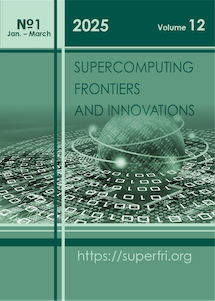Numerical Simulation of the Growth of Localized Disturbances in a Supersonic Boundary Layer over a Plate with Longitudinal Slots
DOI:
https://doi.org/10.14529/jsfi250103Keywords:
numerical simulation, localized disturbances, supersonic boundary layer, laminar-turbulent transition control, surface microrelief, rectangular slotsAbstract
This paper presents the results of numerical simulations of the growth of small amplitude localized disturbances in the boundary layer on a flat plate and on a plate with rectangular longitudinal slots at Mach number 2. The simulations were performed with the FlowVision software under flow conditions corresponding to those in the T-325 wind tunnel of the Khristianovich Institute of Theoretical and Applied Mechanics SB RAS. Cases with slots no deeper than the boundary layer thickness were considered. The localized disturbances in the boundary layer were generated by a time-pulsed, spatially localized heat supply from the plate surface. For a smooth plate, the growth of the disturbances was compared with the results of the linear stability theory. Data agreement was achieved for the grid resolution used. For the cases of the smooth surface and the plate with longitudinal slots, the evolution of disturbances in the boundary layer was analyzed in physical and wave space. In case of the smooth plate, the disturbance introduced into the boundary layer increases monotonically downstream. However, in the presence of longitudinal slots, the growth of the disturbance growth is different and depends on the depth of the slots. It has been shown that longitudinal slots can affect the stability of the supersonic boundary layer. A frequency-wavenumber analysis of the disturbance evolution revealed that longitudinal slots shift the range of the most unstable waves towards a region of higher frequencies compared to the smooth plate. This effect becomes more pronounced with increasing depth of the slots.
References
FlowVision 3.14.01: Users guide. https://flowvision.ru/webhelp/fvru_31401/index.html?numerical_methods.htm (2024), accessed: 2025-04-01
Bippes, H.: Basic experiments on transition in three-dimensional boundary layers dominated by crossflow instability. Progress in Aerospace Sciences 35(4), 363–412 (May 1999). https://doi.org/10.1016/s0376-0421(99)00002-0
Boiko, A.V., Kozlov, V.V., Syzrantsev, V.V., Shcherbakov, V.A.: Riblet control of the laminar-turbulent transition in a stationary vortex on an oblique airfoil. Journal of Applied Mechanics and Technical Physics 37(1), 69–79 (Jan 1996). https://doi.org/10.1007/bf02369404
Chuvakhov, P.V., Egorov, I.V.: Numerical simulation of disturbance evolution in the supersonic boundary layer over an expansion corner. Fluid Dynamics 56(5), 645–656 (Sep 2021). https://doi.org/10.1134/s0015462821050025
Fedorov, A., Novikov, A.: Stabilization of crossflow mode by grooves on a supersonic swept wing. Theoretical and Computational Fluid Dynamics 37(2), 261–268 (Apr 2023). https://doi.org/10.1007/s00162-023-00658-x
Grek, G.R., Kozlov, V.V., Titarenko, S.V.: An experimental study of the influence of riblets on transition. Journal of Fluid Mechanics 315, 31–49 (May 1996). https://doi.org/10.1017/s0022112096002315
Grek, G.R., Kozlov, V.V., Titarenko, S.V., Klingmann, B.G.B.: The influence of riblets on a boundary layer with embedded streamwise vortices. Physics of Fluids 7(10), 2504–2506 (Oct 1995). https://doi.org/10.1063/1.868694
Kachanov, Y.S.: Physical mechanisms of laminar-boundary-layer transition. Annual Review of Fluid Mechanics 26(1), 411–482 (Jan 1994). https://doi.org/10.1146/annurev.fl.26.010194.002211
Kosinov, A.D., Maslov, A.A., Shevelkov, S.G.: Experiments on the stability of supersonic laminar boundary layers. Journal of Fluid Mechanics 219(1), 621 (Oct 1990). https://doi.org/10.1017/s0022112090003111
Kudryavtsev, A.N., Khotyanovsky, D.V.: Direct numerical simulation of transition to turbulence in a supersonic boundary layer. Thermophysics and Aeromechanics 22(5), 559–568 (Sep 2015). https://doi.org/10.1134/s0869864315050042
Lysenko, V.I., Smorodsky, B.V., Kosinov, A.D., Yatskikh, A.A.: Effect of the slot depth on supersonic boundary-layer stabilization. Thermophysics and Aeromechanics 31(1), 71–78 (Jul 2024). https://doi.org/10.1134/s0869864324010086
Mayer, C.S.J., Laible, A.C., Fasel, H.F.: Numerical Investigation of Wave Packets in a Mach 3.5 Cone Boundary Layer. AIAA Journal 49(1), 67–86 (Jan 2011). https://doi.org/10.2514/1.j050038
Ustinov, M., Ivanov, A.: Cross-flow dominated transition control by surface micro-relief. In: AIP Conference Proceedings. vol. 2027, p. 020013 (2018). https://doi.org/10.1063/1.5065091
Ustinov, M.V.: Control of laminar-turbulent transition on a swept wing using surface microreliefs. Fluid Dynamics 53(6), 762–773 (Nov 2018). https://doi.org/10.1134/s001546281806023x
Yatskikh, A.A., Afanasev, L.V.: Numerical simulation of the evolution of localized disturbances generated by two synchronous separated sources in a supersonic boundary layer. Thermophysics and Aeromechanics 29(6), 875–885 (Mar 2023). https://doi.org/10.1134/s0869864322060075
Yatskikh, A.A., Ermolaev, Y.G., Kosinov, A.D., Semionov, N.V.: Evolution of wave packets in supersonic flat-plate boundary layer. Thermophysics and Aeromechanics 22(1), 17–27 (Jan 2015). https://doi.org/10.1134/s0869864314010023
Yatskikh, A., Yermolaev, Y., Kosinov, A., et al.: Evolution of localized artificial disturbance in 2D and 3D supersonic boundary layers. Proceedings of the Institution of Mechanical Engineers, Part G: Journal of Aerospace Engineering 234(1), 115–123 (Jul 2018). https://doi.org/10.1177/0954410018787120
Zhao, R., Liu, X., Wen, C., Wang, X.: Broadband design of acoustic metasurfaces for the stabilization of a Mach 4 boundary layer flow. Advances in Aerodynamics 4(1) (Apr 2022). https://doi.org/10.1186/s42774-022-00106-0
Downloads
Published
How to Cite
Issue
License
Authors retain copyright and grant the journal right of first publication with the work simultaneously licensed under a Creative Commons Attribution-Non Commercial 3.0 License that allows others to share the work with an acknowledgement of the work's authorship and initial publication in this journal.

